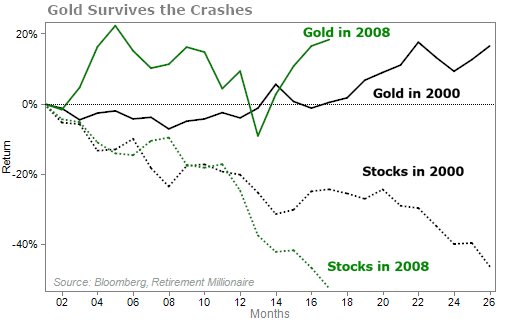Folks outside of finance often think that investing success comes from hot stock tips or being glued to CNBC. That's not really the case.
For most investors, the better path to success is easier, if less dramatic: sorting out a simple asset allocation that suits your needs.
Asset allocation is how you balance your wealth among broad asset classes like stocks, bonds, cash, real estate, commodities, and gold.
It might not be the most exciting part of your investing journey... But keeping your wealth diversified across a mix of investable assets is essential for avoiding losses.
Let's say the stock market has a bad five or 10 years. It's going to happen sometimes. We just don't know when.
By allocating your wealth across many asset classes, you smooth out your returns and can be more confident about having a good-sized nest egg at the end.
Take a look at gold, for example. Longtime readers know that when volatility strikes and investors panic about falling stock prices, they typically turn to the safety of gold.
When the dot-com and housing bubbles burst, gold rose about 20% each time. Take a look...

Now, if during these times, you had been too invested in just stocks, you'd easily have lost more than 40% of your wealth. And at the same time, you'd have missed out on big gains in gold.
I'm not the only one focusing on asset allocation and making sure your portfolio is built for success...
According to my colleague Dan Ferris, a setup 50 years in the making is happening now. And if you're in the right type of assets, you'll not only protect yourself from inflation... but you could also see triple-digit gains this year.
Dan revealed all the details last night. If you missed it, click here to catch up.
Now, let's get into some of the things you've had on your minds this week. As always, keep sending your comments, questions, and topic suggestions to [email protected]. We read every e-mail.
Q: I started lifting weights (again) late last year. Is it better to do more reps with less weight or fewer reps with heavier weights? Thank you and I enjoy your bulletin and monthly subscription. – G.A.
A: The science suggests that there are similar health benefits to both approaches. Either way, you're keeping your muscles and bones strong. Lifting heavier weights does bulk up your muscles more, so that's the way to go if your physique is a priority.
The key is choosing a weight that fatigues your muscles without injuring them. If you can do three rounds of eight to 12 reps without feeling any tiredness in your muscles, the weights are too light. But if you can't even get through that number of reps, the weights are too heavy.
One final point to consider that we've mentioned before... Depending on your current health and age, heavier weights could cause serious injuries like muscle tears and bone fractures. Especially if you're new to weightlifting, start light and work your way up.
Q: I was reading your article about dry skin. I am 78 years old and have another skin problem. It seems that my skin is getting thinner or more sensitive to brushes and tears. Any suggestions on treatments that will help my skin? – F.D.
A: As we age, our skin naturally becomes thinner as our collagen breaks down. Unfortunately, this means your skin is more prone to damage – like bruises, cuts, and tears.
One way to help reduce some of these problems is to keep your skin well hydrated. Better-hydrated skin won't tear as easily as dry skin. In December, we shared three ways to help keep your skin hydrated. If you haven't already, make sure to read that.
In that issue, we discussed how using creams (instead of water-based lotions) locks in your skin's moisture. Some research shows that applying vitamins A, C, or E topically can help slow the breakdown of collagen – and even reverse it in some mild cases. So look for creams that include any of these vitamins.
A diet rich in these vitamins and antioxidants also keeps your skin healthy, and you'll find them in plenty of fruits and vegetables.
Blueberries, my favorite for many reasons, are high in vitamins A and E. Other vitamin A foods include salmon, butter, and hard-boiled eggs. Vitamin E comes in leafy greens, nuts, and seeds. And you can get vitamin C from broccoli, tomatoes, and tropical fruits like kiwis, papayas, and guavas.
What We're Reading...
- Did you miss it? This is the one asset you can always count on.
- Something different: The history of playing cards.
Here's to our health, wealth, and a great retirement,
Dr. David Eifrig and the Health & Wealth Bulletin Research Team
March 3, 2023
